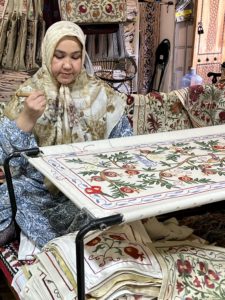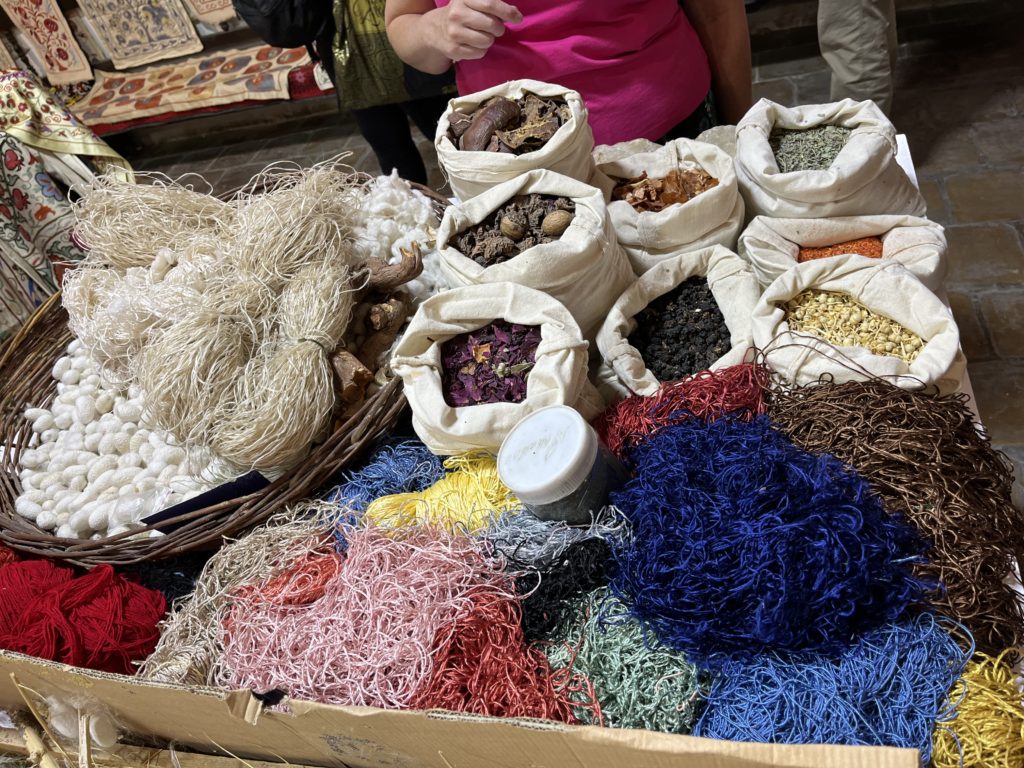 It took two or three days into my visit to Uzbekistan for the subject of the controversial cotton growing industry to come up. We also discussed the silk industry that made the country a key stop in the old Silk Road. Uzbekistan is the largest electricity producer in Central Asia, mainly due to the abundant natural gas reserves and huge Soviet-era power-generation plants. They also are the seventh largest global producer of gold, with copper and uranium not far behind. At first glance (and even second glance), Uzbekistan seems too arid to grow cotton. But cotton production is actually one of most important contributors to the Uzbek economy, accounting for about a fifth of its exports.
It took two or three days into my visit to Uzbekistan for the subject of the controversial cotton growing industry to come up. We also discussed the silk industry that made the country a key stop in the old Silk Road. Uzbekistan is the largest electricity producer in Central Asia, mainly due to the abundant natural gas reserves and huge Soviet-era power-generation plants. They also are the seventh largest global producer of gold, with copper and uranium not far behind. At first glance (and even second glance), Uzbekistan seems too arid to grow cotton. But cotton production is actually one of most important contributors to the Uzbek economy, accounting for about a fifth of its exports.
Decades of Soviet policies to increase cotton production have done severe damage to the Uzbek environment, with agriculture being the main contributor to air and water pollution. Adding in other damaging practices and the growing regional population and industry also contributed to the factors that are shrinking the Aral Sea. Much of the water was, and continues to be, drained for use in irrigating cotton fields. There is also a global concern that Uzbekistan (and others in the region) are using child labor to pick cotton, with the World Bank funding implicated in maintaining the practice. Our guide, when asked for comment, noted that it is the parents who are employed and sometimes children help out because they obviously have to travel with the parents during picking seasons. He insisted that changes have been made to avoid what some activists estimate to be 1.2 million “modern slaves” in Uzbekistan. As always, the reality is more complicated, and it is difficult to get an accurate accounting.
Less controversial is the Uzbek silk industry. The ancient cities of Bukhara and Samarkand were important centers of government and high culture as early as the 5th century BCE, and certainly by the 13th century when Venetian Marco Polo was traveling the area. We got a close up of the silk production process while in Bukhara.
As most people know, silk is a protein fiber produced by certain insect larvae to form cocoons, the intermediate stage between caterpillar and moth (although silk can also be produced by some types of bees, flies, beetles, and spiders). The best-known silk comes from the cocoons of the mulberry silkworm (Bombyx mori), which is found naturally on mulberry bushes in Uzbekistan, but usually reared in great quantities in captivity. The unique triangular prism-like structure of the silk fiber is what gives silk its shimmering appearance.

At one stop in Bukhara, we saw a display of the stages of development of the moth that creates the silk. We also saw how the soft cocoon is spun into a surprisingly coarse flaxen-feeling fiber before further spinning and processing creates a finer thread. Over a hundred mulberry leaves must be eaten by over 3,000 silkworms to produce only 1 kg of silk. The final threads and yarn is incredibly soft and can be dyed into many brilliant colors with dyes derived from a variety of natural vegetation.
We watched one woman doing needlework on a large piece of cotton, painstakingly stitching from one side to another. They also stitch silk on silk, an even more intricate process that takes many hours, days, and even weeks depending on the size of the cloth being embroidered. It was a fascinating process. It was also hard not to purchase something after watching all the work that went into its making, so many in my group (including myself) bought various stitched cloth, scarfs, and more.
One of the benefits of international travel is the opportunity to see local artisans actually making the products. Too often we head to the dollar store to buy something mass produced (often without any human contribution) and don’t appreciate the time and skill that go into hand-made wares. Learning about other cultures is a large part of why I travel, and why we all should travel. As Mark Twain has been reported to say, “Travel is fatal to prejudice, bigotry, and narrow-mindedness….”
I’m still sorting through my “stan” travel photos, so expect more posts in the future. I’ve already booked a trip to Botswana for next summer and will likely have much more before (and after) then. And there is plenty of Abraham Lincoln in the works, so stay tuned.
[Photo Credits: all by David J. Kent, 2023]

Lincoln: The Fire of Genius: How Abraham Lincoln’s Commitment to Science and Technology Helped Modernize America is available at booksellers nationwide.
Limited signed copies are available via this website. The book also listed on Goodreads, the database where I keep track of my reading. Click on the “Want to Read” button to put it on your reading list. Please leave a review on Goodreads and Amazon if you like the book.
You also follow my author page on Facebook.
David J. Kent is President of the Lincoln Group of DC and the author of Lincoln: The Fire of Genius: How Abraham Lincoln’s Commitment to Science and Technology Helped Modernize America and Lincoln: The Man Who Saved America.
His previous books include Tesla: The Wizard of Electricity and Edison: The Inventor of the Modern World and two specialty e-books: Nikola Tesla: Renewable Energy Ahead of Its Time and Abraham Lincoln and Nikola Tesla: Connected by Fate.










